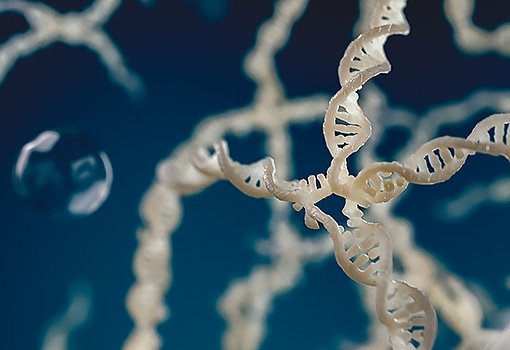“A watched pot never boils,” goes the saying, but that was not the case for researchers from UC Santa Barbara and their partners at the Ludwig-Maximilians University (LMU), in Munich, Germany, when they watched a “pot” of liquids formed from DNA. Their findings appear in the Proceedings of the National Academy of Sciences.
Recent advances in cellular biology have enabled scientists to learn that the molecular components of living cells, such as DNA and proteins, can bind to each other and form liquid droplets that appear similar to oil droplets in shaken salad dressing. These cellular droplets interact with other components to carry out basic processes critical to life, yet little is known about how the interactions function. To gain insight into these fundamental processes, the researchers used advanced methods of nanotechnology to engineer a model system — a liquid droplet formed from particles of DNA — and then watched those droplets as they interacted with a DNA-cleaving enzyme.
Surprisingly, they found that, in certain cases, adding the enzyme caused the DNA droplets to suddenly start bubbling, like boiling water. "The bizarre thing about the bubbling DNA is that we didn't heat the system; it's as if a pot of water started boiling even though you forgot to turn on the stove," says UCSB materials and bioengineering professor Omar Saleh, co-leader of the project. However, the bubbling behavior didn't always occur; sometimes adding the enzyme would cause the droplets to shrink away smoothly, and it was unclear why one response or the other would occur.
To get to the bottom of this mystery, the team carried out a rigorous set of precision experiments to quantify the shrinking and bubbling behaviors. They found that there were two types of shrinking behavior, the first cause by enzymes cutting the DNA only on the droplet surface, and the second caused by enzymes penetrating inside the droplet. "This observation was critical to unraveling the behavior, as it put it into our heads the idea that the enzyme could start nibbling away at the droplets from the inside," notes co-leader Tim Liedl, professor at the LMU, where the experiments were conducted.
By comparing the droplet response to the DNA particle design, the team cracked the case: they found that bubbling and penetration-based shrinking occurred together, and happened only when the DNA particles were lightly bound together, whereas strongly bound DNA particles would keep the enzyme on the outside. Saleh notes: "It's like trying to walk through a crowd — if the crowd is tightly holding hands, you wouldn't be able to get through."
The bubbles, then, happen only in the lightly bound systems, when the enzyme can get through the crowded DNA particles to the interior of the droplet, and begin to eat away at the droplet from the inside. The chemical fragments created by the enzyme lead to an osmotic effect, where water is drawn in from the outside, causing a swelling phenomenon that produces the bubbles. The bubbles grow, reach the droplet surface, and then release the fragments in a burp-like gaseous outburst. "It is quite striking to watch, as the bubbles swell and pop over and over," says Liedl.
The work demonstrates a complex relationship between the basic material properties of a biomolecular liquid and its interactions with external components. The team believes that the insight gained from studying the bubbling process will lead both to better models of living processes, and to enhanced abilities to engineer liquid droplets for use as synthetic bioreactors.
The research was enabled by an award to Professor Saleh from the Alexander von Humboldt Foundation, which enabled him to visit Munich and work directly with Tim Liedl on this project. "These types of international collaborations are extremely productive," Saleh notes.

